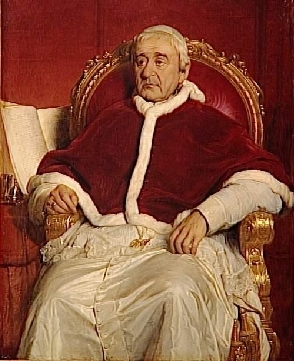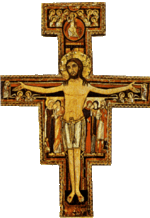Pope Gregory XVI
| Gregory XVI | |
|---|---|
 |
|
| Papacy began | 2 February 1831 |
| Papacy ended | 1 June 1846 (15 years, 119 days) |
| Predecessor | Pius VIII |
| Successor | Pius IX |
| Personal details | |
| Birth name | Bartolomeo Alberto Cappellari |
| Born | September 18, 1765 Belluno, Republic of Venice |
| Died | June 1, 1846 (aged 80) Rome, Papal State |
| Other Popes named Gregory | |
Pope Gregory XVI (18 September 1765 – 1 June 1846), born Bartolomeo Alberto Cappellari, named Mauro as a member of the religious order of the Camaldolese, was Pope of the Catholic Church from 1831 to 1846. Strongly conservative and traditionalist, he opposed democratic and modernising reforms in the Papal States and throughout Europe, seeing them as fronts for revolutionary leftism, and sought to strengthen the religious and political authority of the papacy (see Ultramontanism).
Contents |
Early life
Cappellari was born at Belluno on 18 September 1765 to a noble family. At an early age he joined the order of the Camaldolese (part of the Benedictine monastic family) and entered the Monastery of San Michele di Murano, near Venice. As a Camaldolese monk, Cappellari rapidly gained distinction for his theological and linguistic skills. His first appearance before a wider public was in 1799, when he published against the Italian Jansenists a controversial work entitled II Trionfo della Santa Sede, which, besides passing through several editions in Italy, has been translated into several European languages. In 1800 he became a member of the Academy of the Catholic Religion, founded by Pope Pius VII (1800–23), to which he contributed a number of memoirs on theological and philosophical questions, and in 1805 was made abbot of San Gregorio on the Caelian Hill.
When Pius VII was carried off from Rome in 1809, Cappellari withdrew to Murano, near Venice, and in 1814, with some other members of his order, he moved again, this time to Padua; but soon after the restoration of the Pope in 1814 he was recalled to Rome, where he received successive appointments as vicar-general of the Camaldolese Order, councillor of the Inquisition, prefect of the Propaganda, and examiner of bishops. In March 1825 he was created Cardinal-Priest of San Callisto (in pectore) by Pope Leo XII (1823–29), and shortly afterwards was entrusted with an important mission to adjust a concordat regarding the interests of the Catholics of Wallonia in the predominantly Protestant United Kingdom of the Netherlands. He negotiated peace on behalf of Armenian Catholics with the Ottoman Empire. He discouraged Polish revolutionaries who undermined Tsar Nicholas I's efforts to support the Catholic royalist cause in France, by the necessity of diverting troops to Poland.
Election as Pope
| Papal styles of Pope Gregory XVI |
|
|---|---|
 |
|
| Reference style | His Holiness |
| Spoken style | Your Holiness |
| Religious style | Holy Father |
| Posthumous style | none |
On 2 February 1831, he was, after sixty-four days of conclave, unexpectedly chosen to succeed Pope Pius VIII (1829–30) in the papal chair. His election was influenced by the fact that the cardinal considered the most likely papabile, Giacomo Giustiniani, was vetoed by King Ferdinand VII of Spain. The other major candidates, Emmanuele De Gregorio and Bartolomeo Pacca, had been candidates in the previous conclave. When a deadlock arose between them, the cardinals turned to Cappellari, but it took as many as eighty-three ballots for a decisive result to be obtained.
At the time of election, Cardinal Cappellari was not yet a bishop - the last man to be elected Pope without episcopal consecration. Hence, after his election he was consecrated bishop by Bartolomeo Pacca, Cardinal Bishop of Ostia and Velletri, dean of the Sacred College of Cardinals, with Pier Francesco Galleffi, Cardinal Bishop of Porto e Santa Rufina, sub-dean of the Sacred College of Cardinals, and Tommasso Arezzo, Cardinal Bishop of Sabina, acting as co-consecrators.
The choice of Gregory XVI as his regnal name was influenced by the fact that he had been abbot of San Gregorio monastery on the Coelian Hill for over twenty years. This was the same abbey from which Pope Gregory the Great had dispatched missionaries to England in 596.
Pontificate
The Revolution of 1830 which overthrew the House of Bourbon had just inflicted a severe blow on the Catholic royalist party in France, and almost the first act of the new government there was to seize Ancona, thus throwing Italy, and particularly the Papal States, into an excited condition which seemed to demand strongly defensive measures. In the course of the struggle which ensued, it was more than once necessary to call in Austrian defenders against red-shirted republicans engaged in a terrorist campaign. The conservatives postponed their promised reforms after bombings and assassination attempts. Nor did the replacement of Tommaso Bernetti by Luigi Lambruschini in 1836 mend matters.
Pope Gregory and Cardinal Lambruschini opposed basic technological innovations such as gas lighting and railways, believing that they would promote commerce and increase the power of the bourgeoisie, leading to demands for liberal reforms which would undermine the monarchical power of the Pope over central Italy. Gregory in fact banned railways in the Papal States, calling them chemins d'enfer (literally "ways of hell," a play on the French for railroad, chemin de fer, literally "iron road"). However, under pressure from the French, Gregory was liberal in forgiving imprisoned revolutionaries, a policy which might have aided the final overthrow of Gregory's successor, Pope Pius IX, as temporal ruler in 1870.
Gregory XVI made great expenditures for defensive, architectural and engineering works, and was a major patron of learning in the hands of Angelo Mai, Giuseppe Mezzofanti, Gaetano Moroni. However, these large expenditures left the Papal States much weaker financially.
The insurrections at Viterbo in 1836, in various parts of the Legations in 1840, at Ravenna in 1843 and Rimini in 1845, were followed by wholesale executions and severe sentences, hard labour or exile; still the Papal States continued to have considerable unrest.
In 1839 Gregory issued an encyclical against slavery, In Supremo Apostolatus, and canonized St Veronica Giuliani, an Italian mystic. Gregory died on June 1, 1846.
| Catholic Church titles | ||
|---|---|---|
| Preceded by Giulio Maria della Somaglia |
Prefect of the Congregation for the Propagation of the Faith 1826 – 1831 |
Succeeded by Carlo Maria Pedicini |
| Preceded by Pius VIII |
Pope 1831 – 1846 |
Succeeded by Pius IX |
References
See also
- List of encyclicals of Pope Gregory XVI
|
|||||||||||||||||||||||||||||||||||||||||||||
|
|||||||||||||||||||||||||||||||||||||||||

